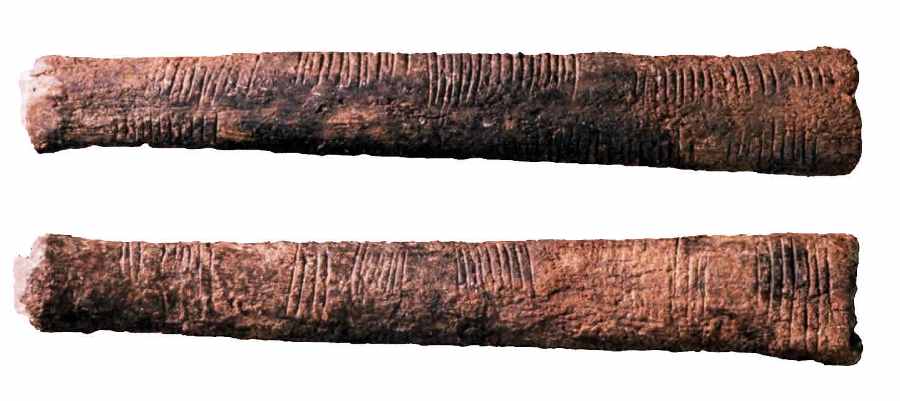|
The Artifacts |
||||
|
..
Photo of the Ishango bone from two different points of view. Ishango Bone
The Ishango bone
is a bone tool,
dated to the Upper Paleolithic era. It is a dark
brown length of bone,
the fibula of a baboon, with a sharp piece of quartz
affixed to one end,
perhaps for engraving or writing. It was first
thought to be a tally stick,
as it has a series of tally marks carved in three
columns running the length
of the tool, but some scientists have suggested that
the groupings of notches
indicate a mathematical understanding that goes
beyond counting.
The Ishango bone was found in 1960 by Belgian Jean de Heinzelin de Braucourt while exploring what was then the Belgian Congo. It was discovered in the African area of Ishango, which was centered near the headwaters of the Nile River at Lake Edward (now on the border between modern-day Uganda and Congo). The bone was found among the remains of a small community that fished, gathered, and grew crops in this area of Africa. The small settlement had been buried in a volcanic eruption. The artifact was first estimated to have originated between 9,000 BC and 6,500 BC. However, the dating of the site where it was discovered was re-evaluated, and is now believed[who?] to be more than 20,000 years old. The Ishango bone is on permanent exhibition at the Royal Belgian Institute of Natural Sciences, Brussels, Belgium. Contents Meaning of the Tally Marks Mathematical calculations?
The three columns of asymmetrically grouped notches imply that the implement was more functional than decorative. The Ishango grouping may have been used to construct a numeral system. The central column begins with three notches, and then doubles to 6 notches. The process is repeated for the number 4, which doubles to 8 notches, and then reversed for the number 10, which is halved to 5 notches. These numbers then, may not be purely random and instead suggest some understanding of the principle of multiplication and division by two. The bone may therefore have been used as a counting tool for simple mathematical procedures. Furthermore, the number of notches on either side of the central column may indicate more counting prowess. The numbers on both the left and right column are all odd numbers (9, 11, 13, 17, 19 and 21). The numbers in the left column are all of the prime numbers between 10 and 20 (which form a prime quadruplet), while those in the right column consist of 10 + 1, 10 − 1, 20 + 1 and 20 − 1. The numbers on each side column add up to 60, with the numbers in the central column adding up to 48. Both of these numbers are multiples of 12, again suggesting an understanding of multiplication and division. Alexander Marshack examined the Ishango bone microscopically, and concluded that it may represent a six-month lunar calendar. Claudia Zaslavsky has suggested that this may indicate that the creator of the tool was a woman, tracking the lunar phase in relation to the menstrual cycle. References
Further reading
External links |
||||
| FAIR USE NOTICE: This page contains copyrighted material the use of which has not been specifically authorized by the copyright owner. Pegasus Research Consortium distributes this material without profit to those who have expressed a prior interest in receiving the included information for research and educational purposes. We believe this constitutes a fair use of any such copyrighted material as provided for in 17 U.S.C § 107. If you wish to use copyrighted material from this site for purposes of your own that go beyond fair use, you must obtain permission from the copyright owner. | ||||
|
|




